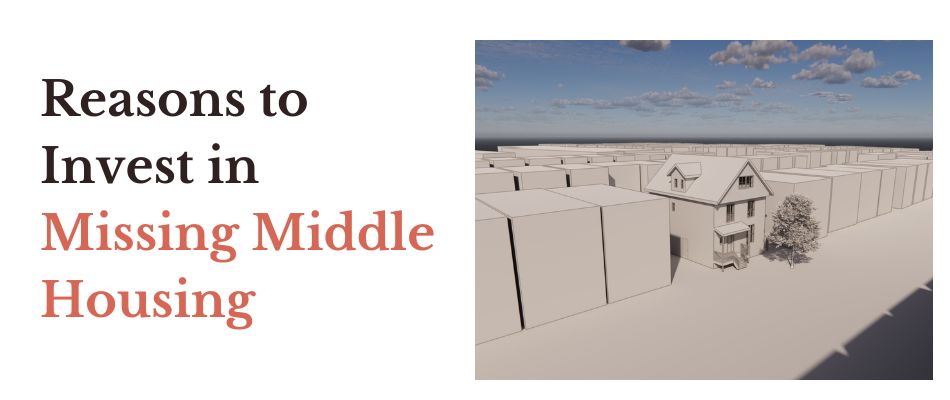Missing middle housing is a fascinating term that describes a response to the housing crisis in Canada. Now more than ever, there is a need for homes that cater to varying family makeup and socio-economic status. Household sizes are shrinking, and our population is aging. Many cities and regions across Canada need to catch up on housing supply. This has made the cities throughout Ontario begin introducing exclusionary zoning. Many municipalities, including Toronto, are rolling out programs that increase density in lots that traditionally only allow single family homes. So adding laneways or garden suites and multiplexes is becoming common place.
Hence, it makes more sense now than ever to create neighborhoods with various housing types, from condominiums to single families. However, it’s essential to understand the foundations of missing middle housing. This article provides insights on missing middle housing to help homeowners and investors learn how to seize advantage to respond to today’s housing crisis and maximize ROI on property investments.
What Is Missing Middle Housing?
Missing middle house refers to a range of dwelling types between single-family homes and large-scale apartment buildings. It’s not easy to see quickly the need for the missing middle housing. However, the gap in the market becomes apparent when considering the limited choices available to residents, often going between extremes such as detached homes and high-rise living like large-scale residential towers.
Missing Middle Housing steps in to offer a middle ground. This nuanced solution bridges the gap in the housing market by providing a spectrum of dwelling types that can cater to a broad demographic, presenting options for various lifestyles, preferences, and life stages.
Beyond that, we can also define this type of housing as a middle price range between subsidized or rent geared to income and luxury units for the affluent. It is the sweet spot where two definitions of coverage collide.
Types of missing middle housing units
One of the distinctive features of Missing Middle Housing is its profound ability to encourage diversity within existing communities. In conventional housing models, the transition between different stages of life often prompts individuals and families to relocate outside of the cities they enjoy. For instance, young professionals move to surrounding cities because middle housing is unavailable. This can cripple a city when it begins to happen at scale. In contrast, missing middle housing creates scenarios where different generations can co-exist within the same neighborhood. For instance, multiplex can allow aging parents to live with adult children while maintaining their privacy and independence. This, in turn, fosters a sense of community and familial connection.
Here are examples of missing middle houses in various forms, including:
- Duplexes This single-family dwelling is vertically or horizontally separated into two distinct living units. These are small, self-contained homes on the same lot as a larger dwelling that is typically used as rental units.
- Triplex is a dwelling that contains three distinct living units with separate entrances on the same lot. These can often be seen in existing 2-story single-family homes that were converted. The floor plans are typically divided into units with shared or independent entry.
- Fourplexes: This residential building is a 2 ½ storey building with four independent living units with separate entrances and a shared stairwell. These are typically used as rental units or for larger families that require more space or intergeneration arrangements.
- Multiplexes: These small-scale, low-rise apartment buildings were single-family residential houses that have undergone significant modification to accommodate five or more self-contained dwelling units. They offer a broader mix of unit sizes, from studios and one bedroom to two and three bedrooms. This houses diverse household structures.
Each of these missing middle housing types offers a range of living arrangements that contribute to the fabric of a community. These units can redefine neighborhoods and how cities address a housing crisis while fostering a sense of diversity within existing communities.
The importance of missing middle housing
Building local communities
Investing in missing middle housing goes beyond financial gains. It contributes to local economies by supporting businesses and creating spaces facilitating sustainable small-scale development. This type of housing fosters demographic diversity, ensuring a dynamic mix of residents within a community.
Increased affordability
At its core, missing middle housing offers a more affordable rental income than other housing types like single-family homes and high-rise apartments. This is because they are often smaller and have fewer amenities, which means their cost is less to build/renovate. Yet, they have many incredible benefits for homeowners and real estate investors, including rental income.
Urban revitalization
Missing middle housing plays a pivotal role in the urbanization. By provisioning diverse housing options, missing middle housing creates gentle densification where the infrastructure, like schools, roads, transit, etc., exists. Hence, missing middle housing is sustainable and efficiently uses a city’s services. Theoretically, this should benefit all residents as a more dense community of users carries the cost of infrastructure maintenance.
Support local businesses.
Missing middle housing often creates walkable and vibrant neighborhoods. This density can support local businesses. As the number of plexes increases in these communities, so does the number of residents, supporting thriving local businesses and building stronger communities.
Missing middle demographics
Missing middle housing can appeal to various demographics and individuals in various socio-economic spheres, including single-female households, single-person households, young professionals, downsizing baby boomers, seniors, and more. Many demographics often seek independence, affordability, community, and security.
Enhance livability
Missing middle housing projects tend to fit within walkable neighborhoods with restaurants, small markets, and coffee shops. These amenities contribute to the live, work, and play ideology. When done well, this missing middle housing provides all the enhancements to create stable life occupants.
Missing middle housing is also profitable.
Missing middle projects are also excellent because they can be feasible developments with or without government incentives. Hence, whether a single homeowner, real estate investor, or small-scale developer, you can renovate an existing house and convert it into a multiplex building. While it is not simple, the rewards can outweigh the risk.
Facilitates gentle and sustainable small-scale development
Missing middle housing champions a model of development that reduces the carbon footprint associated with sprawl and urban boundary expansion. This gentle form of densification is sustainable and supports environmental initiatives. Municipalities can preserve more farmland, wetlands, and natural habitats by prioritizing missing middle housing types. This approach ensures that urban development aligns with sustainability principles, creating lasting benefits for residents and the environment.
How to invest in ‘missing middle’ housing as a homeowner and real estate investor
As a homeowner and real estate investor, there are many ways to invest in missing middle housing. It is common to purchase a turnkey missing middle housing property and use it as a primary residence with rental suites or as an investment property. However, when purpose-built or converted, these properties can be lucrative assets, so you’d be hard-pressed to find one listed.
Converting existing buildings into missing middle housing units
This is a fantastic way to invest in missing middle housing because it can be less expensive than a purpose-built multiplex. There are a few different ways to convert existing buildings into missing middle housing units, such as:
- Converting existing commercial buildings into residential units: This is an excellent option if a commercial building is located in a desirable neighborhood. You can convert these buildings into multiple units. In fact, if the commercial component of the building is maintained, the mixed-use asset can be a unique addition to any investor’s portfolio. Also, be sure to investigate if a community investment Program (CIP) applies. This can mean savings through government incentives.
- Converting existing duplexes or triplexes and fourplexes into higher uses: Because most municipalities previously only allowed duplexes, it is an excellent investment to source these properties in communities now allowing more dwelling units on a lot. This is done by shrinking the floor area of existing units, underpinning crawl spaces into full basements and converting attic spaces with dormers for headroom, converting an attached garage into a studio, increasing the number of storeys to an existing dwelling, and constructing new additions to contain suites.
- New Infill Purpose Build: These are especially great if a lot can accommodate 8-10 units. It costs more and takes more time to plan and construct, but the result is often worth the risk. Finding these properties is the trick, so speak with a knowledgeable multiplex, planning, and design team.
Challenges adding second or third units to your property Financing investments
Finance investments
There are three basic ways to finance investments in missing middle housing. Traditional mortgage financing is still a good option if you have an excellent credit history and steady income. You can also get a construction or renovation loan by applying to the many programs created to aid homeowners and developers in creating rental units in missing middle housing. CMHC insures these and must meet thresholds for unit count, energy efficiency, affordability, and accessibility. So speak with your mortgage professional. Of course, you can always borrow private money. And though it can be expensive, it may be worthwhile if the project is feasible.
Understanding local bylaws and regulations involved
Before now, local bylaws did not allow for missing middle housing projects. However, recent regulations are relaxing to encourage them. However, ensuring that your renovations of single-family units into multiplex buildings adhere to the Ontario Building Code and zoning bylaws is vital.
Transforming unused space into income-generating spaces requires understanding how to meet the requirements. We recommend contacting a BCIN designer to help assess your property’s highest and best use (H&BU)and bring your visions into reality.
Conclusion
Due to the relaxed regulations, missing middle housing projects are becoming increasingly popular and doable in Ontario. Middle housing is a crucial response to the housing crisis in Canada. It aims to provide diverse housing options that cater to varying family compositions and socioeconomic statuses. This type of housing fills the gap between single-family homes and large-scale apartment buildings, offering a middle ground for residents. By embracing missing middle housing, homeowners and investors can respond to the housing crisis while maximizing returns on property investments.


